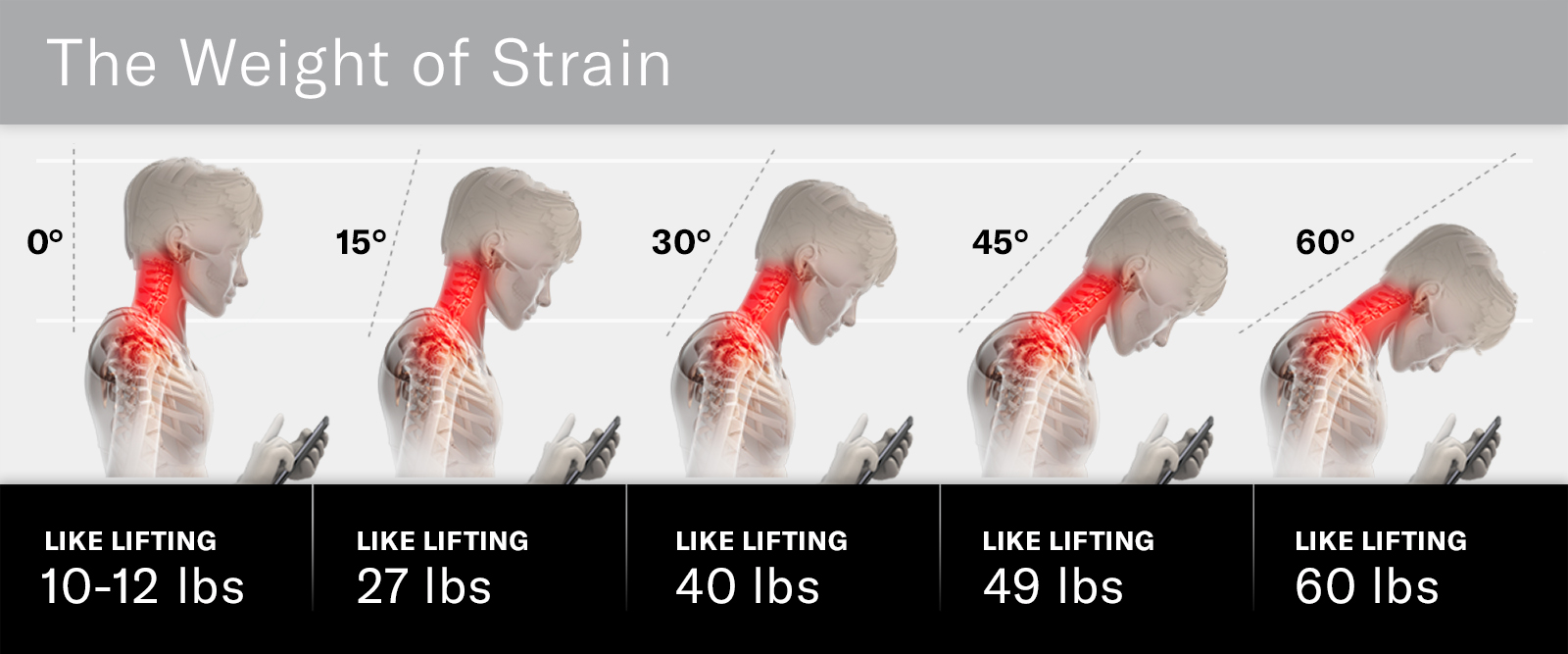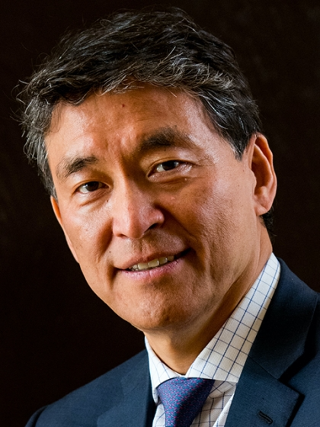How to Prevent and Fix ‘Tech Neck’
Long hours spent on electronic devices can take a toll on your neck and shoulders. A spine expert offers tips for addressing tech-related neck and shoulder pain.

You see it everywhere — in homes and offices, while walking down the street, or when standing in line: “tech neck,” or the act of stressing your muscles while using phones, tablets, and computers. It’s a problem that’s bound to get worse as people spend more time on their devices. According to the digital reference library DataPortal, Americans spend an average of seven hours per day on screens. This can result in headaches, neck spasms, soreness and creaky shoulder joints caused by holding your neck still for long periods, says Dr. K. Daniel Riew, a world-renowned cervical spine surgeon and co-director of Och Spine at NewYork-Presbyterian/Weill Cornell Medical Center. So how do you fix tech neck?
Dr. Riew breaks down the causes and symptoms of tech neck and offers ways to correctly and safely align your body while using your digital devices.

Dr. K. Daniel Riew
What causes tech neck?
Dr. Riew: When you’re working on a computer or looking down at your phone, the muscles in the back of the neck have to contract to hold your head up. The more you look down, the more the muscles have to work to keep your head up. These muscles can get overly tired and sore from looking down at our smartphones, computers, or tablets all day. That’s what we call tech neck.
What are the symptoms of tech neck?
Headaches, stiff necks, neck spasms, and pain between the shoulder blades are common complaints. Some people say they have a hard time looking up after looking down for a long time. When you look down just 45 degrees, your neck muscles are doing the work of lifting an almost 50-pound bag of potatoes. That puts a lot of strain on your neck joints as well as your discs and contributes to them wearing out. In severe situations, you could get numbness, tingling, or weakness that goes down into your arms because of a pinched nerve in your neck.

How can you prevent tech neck?
Most people have been told to sit up straight when working on a computer. Unfortunately, this is incorrect advice. When you sit with your back straight, you not only put a lot of force on the discs in your lower back, but the muscles in the back of the neck have to contract to hold the head up. So, if you sit up straight for hours, you may end up with both back and neck pain.
A better way to sit is with the chair reclining 25 to 30 degrees with good lumbar support to prevent slouching. In this position, the discs in the back as well as the neck are subjected to much lower forces than in an upright position, and the muscles in the back of the neck no longer have to contract to hold your head up.
When you lean back, part of your body’s weight goes into the chair, instead of straight down your spine. So your spine sees a lot less force and, as a result, you hurt a lot less. Most people do this intuitively by using reclining chairs when they are relaxing because it doesn’t hurt the neck or back as much as sitting straight.
If you have tech neck, how can you alleviate the symptoms?
Number one is to get up and move frequently. If you have a sedentary job, at least every 15 to 30 minutes, you should get up and walk around, even if it’s for a minute. That’ll get blood circulating and it will get your neck in a different position. It’s not only good for your neck, but also the rest of your body. Studies show that sitting for long periods is dangerous to your heart and that it leads to a shortened life span.
Number two, get a chair that reclines with very good lumbar support, and lean back as much as is practical while you’re working. That will take the pressure off the neck muscles so that they aren’t strained. You can tell if you are leaning back adequately by doing the following: First, if you were to fall asleep in that position, your neck should fall backward. Alternatively, if you put your hand at the back of your neck as you lean forward, you’ll find that the neck muscles contract and stiffen up. As you lean backward, they will relax and get soft.
Number three, see if you can work standing up as much as possible.
When you look down just 45 degrees, your neck muscles are doing the work of lifting an almost 50-pound bag of potatoes.
Dr. K. Daniel Riew
Are there other lifestyle changes that can help?
If you have neck pain that really bothers you, I recommend doing some form of aerobic exercise on a regular basis. That could be jogging, swimming, walking at a brisk pace, or using ellipticals or recumbent stationary bicycles. When you do aerobic exercise, it sends oxygenated blood to those tired muscles and washes away the chemicals that cause inflammation and pain.
If you do it for a sustained period, about 20 to 30 minutes three or four times a week, getting your heart rate and respiratory rate up and working up a good sweat, that will keep your neck and back much healthier. It will also help ease the tension in the back of the neck.
Can tech neck lead to more serious problems?
What happens initially is that the muscles have to strain to hold your head up. But the muscles tighten and, as they do, they put more pressure on the discs. That makes the discs wear out faster, and as the discs wear out, they can bulge or even rupture. If the ruptured disc pinches a nerve, you can get pain, weakness, or numbness in the arm, which may end up requiring surgical treatment.
How to Fix Teck Neck
While the pain and discomfort associated with tech neck can be taxing, there are a number of ways you can do to help reverse the effects. Dr. Riew shares a few tips that can help you get rid of tech neck.
- Perform range of motion exercises. Periodically throughout the day, turn your head to look in every direction — up, down, left, and right — to stretch the extensor muscles in your neck.
- Look up. Looking up is especially important to help reverse what happens when you spend so much time looking down. If you are looking at something straight ahead, lift your head and look up every 10-15 minutes to extend your neck.
- Stay moving throughout the day. Sitting for long stretches is not good for you. If you have a desk job, get up and walk around, go up and down stairs, or, if you have the space, do some jumping jacks every 1 to 2 hours.
- Use the force. Using gentle resistance, link your hands behind your head and extend your neck against the resistance that your hands provide. Hold this for a few seconds, and repeat 5 to 10 times for every hour that you look down. This will strengthen your neck extensor muscles. Don’t use too much force, though. You don’t want a neck like a football player. Over strengthening can lead to neck problems later in life.
- Do some cardio. Doing exercises that increase your heart and respiratory rate on a regular basis will help keep your spine healthy. This nourishes tired muscles and reduces inflammation and pain. This won’t prevent age-related degeneration, but it can significantly decrease the risk of experiencing tech neck symptoms as you get older.
When should one see a doctor?
If you have tech neck, the last person you should see is a surgeon. It would be better to see a physical medicine and rehabilitation (PM&R) doctor first, also known as a physiatrist. They are doctors who take care of bone and joint problems in a non-operative manner. We have several of the top PM&R doctors in the world at Och Spine at NewYork-Presbyterian. If their non-operative measures don’t work or if you have ongoing problems such as constant numbness or weakness in the arms, then it’s time to consider surgery and see a surgeon.
Dr. K. Daniel Riew serves as co-director of Och Spine at NewYork-Presbyterian/Weill Cornell Medical Center, professor of orthopedic surgery in neurological surgery in the Department of Neurological Surgery at Weill Cornell Medicine and professor of orthopedic surgery in the Department of Orthopedic Surgery at Columbia University Vagelos College of Physicians and Surgeons. He also sees patients at Och Spine at NewYork-Presbyterian/The Spiral, a new state-of-the-art spine center in midtown Manhattan that brings together spine care specialists from Columbia and Weill Cornell Medicine. For the last 20 years, Dr. Riew has focused exclusively on the surgical treatment of cervical spine problems. He is one of only a handful of surgeons in the world whose practice is limited to the operative treatment of the cervical spine.
